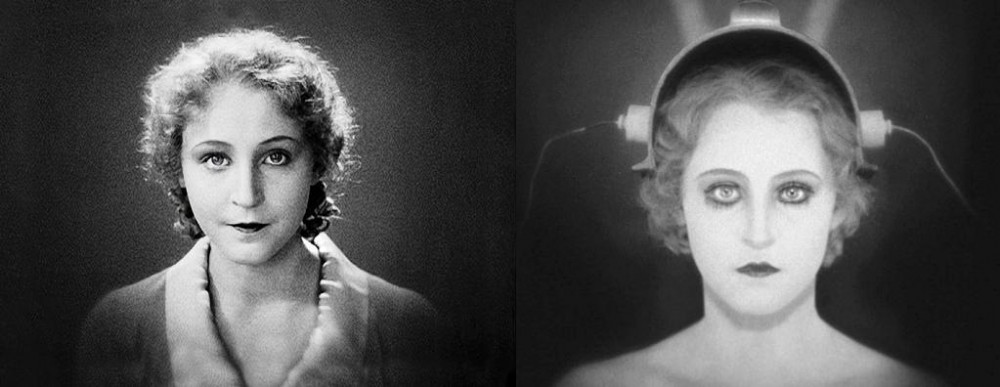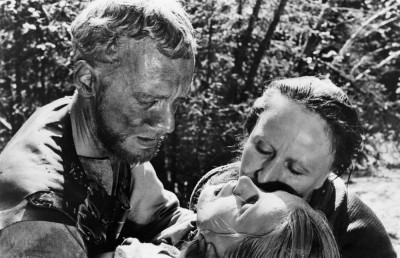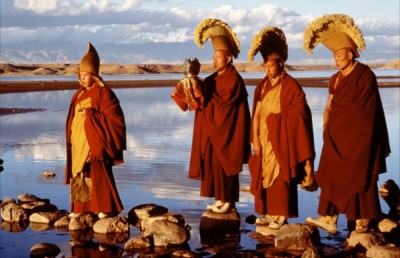The Contemporary Dopplegänger

The doppelgänger (German for double) theme has been one of the most persistent in all the arts, finding particularly heightened moments during the Romantic period and at the turn of the 20th century. One could trace its origin to Plato’s famous Cave metaphor, where imprisoned spectators view shadows on the wall which, not knowing more than this existence, they assume to be “reality.” Today’s moviegoers may not be tied down to their seats or be fooled by the nature of the images, but still buy into the illusion. Perhaps because film’s doubling effect is the most convincing and authentic of all the arts. Authentic enough, so the myth goes, that the virgin spectators watching Lumiere’s train entering the station moved in fear of being trampled upon. Some of that initial fear and awe persists in every moving image, with film acting out a Utopian reflection of reality. Author Paul Coates sees film as “The Story of the Lost Reflection” (The New Left Review #143, 120-128) and begins his essay with the sentence, “The film image is an alienated reflection -an imitation of life perilously similar to the original.”
The doppelgänger is present at every level in film: thematically, formally, technologically, and theoretically. It cuts across nations and genres. The term, being of German origin, was first used critically to define an important aspect of German art, beginning with Romanticism (Hoffmann), Expressionism and, of course, the classic period of German Expressionist cinema (1919-1930). Many of the great Expressionist films deal formally and thematically with the doppelgänger, through such themes as the whore/madonna complex, (the two Maria’s in Metropolis), split personages ( Der Januskopf ), character degeneration (The Blue Angel, The Last Laugh), immortality (Faust) and visual tropes such as chiaroscuro lighting (light/dark) and mirror imagery. The doppelgänger cuts across nearly every genre. We see it present in the science-fiction genre in such themes as alien take-over ( Invasion of the Body Snatchers , I Married a Monster from Outer Space ), the us/them mentality of 1950’s science-fiction, parallel or alternative universes (Planet of the Apes , Planet Earth ), the body/mind (Seconds ) and consciousness/reality split (Solaris , Event Horizon ), and science/religion (Frankenstein , War of the Worlds ). It forms a major part of the Western iconography: East/West, community versus individual, civilization versus wilderness, gunslinger versus lawman, barfly versus schoolmarm (whore/madonna in the west), and nature/culture (each paradigmatically present in My Darling Clementine ).
Even a genre as disconnected from the above as the comedy can not escape the influence of the double. Who can forget the rich man in Chaplin’s City Lights, that treats Charlie the tramp adorably when drunk and with disdain when sober. Or the many instances of Chaplin playing dual roles, most notably as the kindly barber and the Hitlerian tyrant in The Great Dictator ; or in drag; or the dual life he leads as bluebeard murderer and caring husband in Monsieur Verdoux. The double becomes an aesthetic model in Jacques Tati’s classic Mon Oncle, with sound, color and mise-en-scène divided along the lines of the old rural French quartier and the urban, modern suburbia. What is the dynamics of comedy teams if not a personification of the doppelgänger: skinny (Stan Laurel, Terence Hill) and fat (Oliver Hardy, Bud Spencer); tall (Bud Abbott, Dean Martin, Chong, Fred Flinstone) and short (Lou Costello, Jerry Lewis, Cheech, Barney Rubble); ugly (Lewis, Cheech, Spencer) and good looking (Martin, Chong, Hill); stupid (Laurel, Costello, Lewis) and smart (or less stupid Hardy, Abbott, Martin); “unfunny” (George Burns, Abbott) and funny (Gracie Allen, Costello); black (Richard Pryor) and white (Gene Wilder).
No genre is more dependent on the doppelgänger than the horror film. Regardless of how you split or define it, the horror genre would not exist without it: the living and the undead (vampires, zombies, Frankenstein’s monster), good/evil, light/dark, day/night (vampires, werewolves), human/monster (vampire, werewolf, Dr. Jekyll & Mr. Hyde, the invisible man), split personality (Psycho, Sisters , Dr. Jekyll & Mr. Hyde, the werewolf), nature/culture (The Birds, King Kong, Prophecy, Jaws).
Acting and casting can sometimes reflect the doppelgänger in interesting ways that also cut across genres. The most obvious way is when the same actor plays two roles, such as the example from The Great Dictator noted above. However, the effect can vary greatly in levels of complexity and narrative import. For example, Kim Novak in Vertigo seems to be playing two separate roles but in fact is the same person acting out a game of deception. In the stylish, black-comedy zombie film Dellamorte Dellamore the same actress, Anna Falchi, dies and returns as three separate characters who may very well be aspects of the same woman or aspects of the central character’s dream world. In Bernardo Bertolucci’s The Spider’s Stratagem the same actor, Guilio Brogi, plays both son in the present (1970) and father in the flashback scenes (1936). Throughout the film Bertolucci blurs the distinction between the father/past and the son/present. Characters from the present that appear in the flashbacks are played by the same actors, which creates the strange temporal effect of maintaining the same age difference between them and the father as between them and the son in the present. Events in the present begin to mirror those of the past. The son becomes the father’s alter ego; the present fuses with the past. In this case the decision to use the single actor to play two roles relates directly to the film’s peculiar treatment of history. One of the most audacious doppelgänger effects in casting occurs in Luis Bunuel’s That Obscure Object of Desire, which recounts the story of a widower, played by Fernando Rey, who falls in love with his maid. The trick is that the maid is played interchangeably by two actresses, Carole Bouquet and Angela Molina! The effect is even stranger for the audience because Rey, of course, does not react to the changes. A similar audience play/ploy occurs in the bizarre identity thriller Suture (1993, co-directed by Scott McGehee and David Siegel). In this case a black man (Dennis Haysbert) and a white man (Michael Harris) play “identical” half-brothers. The black man remarks, “Isn’t it remarkable, how much we look alike?” Even apart from the racial difference, they look nothing at all alike; yet the plot is dependent on everyone else thinking they look alike. A recent take on doppelgänger acting is John Woo’s Face-Off, where two characters swap faces and must “act” and behave like their counterpart.
Even the illusion of movement that defines and makes film possible is predicated on the constant interplay between light and dark. With film and the doppelgänger so interwoven it is not surprising that the theories we use to help define and understand film (or sometimes confuse ) are also infused with the notion of the double. The greatest proponent of film realism, André Bazin, uses variations on the double to define film’s ontological relationship to reality: a decal, a transfer, a tracing, an impression in light, a mold, an imprint. Soviet montage theories are couched in terms such as dialectical, parallel, and “montage of attractions.” Structuralism erected binary categories to reveal the deep, underlying patterns and meanings in film. Psychoanalysis, by its very nature, relied heavily on doubling concepts: absence/presence, disavowal, the repetition compulsion, the mirror stage, the uncanny, the return of the repressed.
All of this leads me to the initial impetus for this essay: the appearance of an innovative twist on the doppelgänger. Several recent films have reflected the doppelgänger in the way their narratives dramatically fragment. By this I do not mean like Psycho, where the narrative and the audience identification is detoured when the central character is murdered. The bifurcation is much more radical and severe and the effect is akin to a split personality narrative. The most striking case is Wong-Kar Wai’s art house hit Chungking Express, where the plot begins with one set of characters and then inexplicably shifts to another. The initial male character we meet is a depressed policeman named He Qiwu (Takeshi Kaneshiro), who pines after his ex-girlfriend. A mysterious, dangerous woman involved in drug trafficking (Brigitte Chin-Hsia Lin in a blond wig) enters his life. Without warning or reason, the plot switches to a new couple: a young, attractive waitress (Faye Wang) who works at a fast-food counter frequented by the initial policeman, and a second policeman who visits the same food bar, Tony Chiu-Wai Leung. Another recent split-personality film is the Tarantino/Rodriguez From Dusk Till Dawn (1995), which does a genre transformation midway through the film from taut hostage thriller to over-the-top vampire gorefest.
Equally striking is the character/narrative switch in David Lynch’s noir-horror Lost Highway. Roughly a third of the way into the film, saxophonist Fred Madison (Bill Pullman) is convicted of murdering his wife (played by Patricia Arquette) and placed in prison. The guard checks the cell the next day and, magically, Madison is no longer there but in his place a younger man named Pete Dayton (Balthazar Getty). Like Kim Novak in Vertigo, Arquette also returns in this “new” narrative as another character (her hair has gone from dark to light, the reverse of Novak’s hair change). Lost Highway frighteningly reinvents the doppelgänger. Everything splits and bends in Lost Highway: characters, the narrative, time/space. Lynch visualizes this in the final scene where Fred Madison’s head literally comes apart at the seams while driving away/into(?) a black abyss.
In Kieslowski’s The Double Life of Veronique two kindred souls disunited in space are united spiritually through death, causing a fragmentation in the narrative (though less radical than in Chungking Express). The film establishes the presence of these two identical souls who are unaware of each other’s existence, Veronika, a gifted classical singer living in Poland, and Veronique, a music teacher living in France (both played by the same actress, Irene Jacobs). Thirty minutes into the film the Polish woman dies tragically during her first performance. At the moment of her death the camera cuts to a quick moving camera shot craning above the audience, an astral projection of her departing soul. At this moment the location cuts to France where the narrative shifts to follow the soul mates life.
These recent examples are indications of the inexhaustibility of the doppelgänger. And perhaps more. Paul Coates notes that, “many legends associate the vision of the double with the imminence of death” (120). The feeling of death or of mortality, whether literal or figurative, is stronger during heightened (i.e. symbolic) historical moments, such as the turn of the century. Which explains why, according to Coates, “the literature of the fin-de-siècle is aswarm [sic] with mirror and doubles” (121). It is only fitting then, that with less than one thousand days to the 21st century, the influx of doppelgänger imagery reinvents and mirrors itself.












